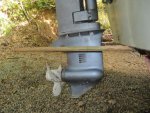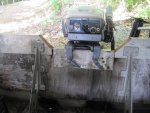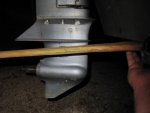Re: 1974 15hp evinrude low wot rpm with factory prop?
I'm not an expert on anything, and I'm not trying to be a wize guy or anything. But I hear a lot of people talking about cavation and ventilation/aeration, and confusing the two. And so did I until about 15 years ago right after I bought my first boat. Then my boss gave me a copy of Chapman's Piloting, Steamship & Small boat handling. And was I ever surprized when I found out what they actually meant.
Enjoy,
?"Propeller ventilation" is caused by air from the surface or exhaust gases being drawn into the rotating propeller blades. This results in the propeller slipping more than usual due to the reduced water load on the blades. The obvious symptoms of this are a sudden increase in engine RPM (over-reving) as well as a possible loss of speed. This commonly occurs when trying to turn the boat at high planing speeds or if the outboard or sterndrive is trimmed out too high.
In racing conditions this can also occur when following another boat too closely. The small bubbles in the water created by the leading boat can cause ventilation of the propeller of the following boat, with a subsequent loss of speed. This is why you rarely see high speed race boats following directly in the line of the leading boats, even if they are far enough back to be out of the spray and wake.
Most drives and outboards have a plate above the propeller area designed to keep surface air from entering the blade area. This plate is correctly called the "anti-ventilation plate", although you will often see it referred to as the "anti-cavitation plate". Through-hub exhaust systems also have specially designed hubs to keep exhaust gases from entering the blade area.
"Propeller cavitation" is less obvious than ventilation, but can be far more damaging. When the propeller blade passes through the water at an increasing speed, the pressure that holds the water to the sides of the blades is lowered. If the water is sufficiently warm, and depending on the speed of the boat, boiling can occur forming steam bubbles. During normal propeller operation, low pressure exists on the blade back. Normally, the pressure does not drop low enough for boiling to occur. However, ventilation, poor blade design or selection, or blade damage can cause an unusual pressure drop on a small area of the blade. Boiling can occur in this small area. As the water boils, bubbles bubbles form. As the boiling water passes to a higher pressure area of the blade, the boiling stops and the bubbles collapse. The collapsing bubbles release enough energy to erode the surface of the blade. This entire process of pressure drop, boiling, and bubble collapse is called "cavitation" and the damage caused by the collapsing bubbles is called a "cavitation burn". It is important to remember that cavitation is caused by a decrease in pressure, not an increase in temperature. One of the advantages of stainless steel propellers is that due to their superior strength they can withstand cavitation damage better than aluminum and can also be produced with thinner blades to reduce the occurrence of cavitation.?
I just think it is amazing that the propeller go fast enough to boil water. It's sort of like the space shuttle on re-entry gets red hot. Amazing.























